90% of Americans say the internet has been essential or important to them, many made video calls and 40% used technology in new ways. But while tech was a lifeline for some, others faced struggles

Pew Research Center has a long history of studying technology adoption trends and the impact of digital technology on society. This report focuses on American adults’ experiences with and attitudes about their internet and technology use during the COVID-19 outbreak. For this analysis, we surveyed 4,623 U.S. adults from April 12-18, 2021. Everyone who took part is a member of the Center’s American Trends Panel (ATP), an online survey panel that is recruited through national, random sampling of residential addresses. This way nearly all U.S. adults have a chance of selection. The survey is weighted to be representative of the U.S. adult population by gender, race, ethnicity, partisan affiliation, education and other categories. Read more about the ATP’s methodology.
Chapter 1 of this report includes responses to an open-ended question and the overall report includes a number of quotations to help illustrate themes and add nuance to the survey findings. Quotations may have been lightly edited for grammar, spelling and clarity. The first three themes mentioned in each open-ended response, according to a researcher-developed codebook, were coded into categories for analysis.
Here are the questions used for this report, along with responses, and its methodology.
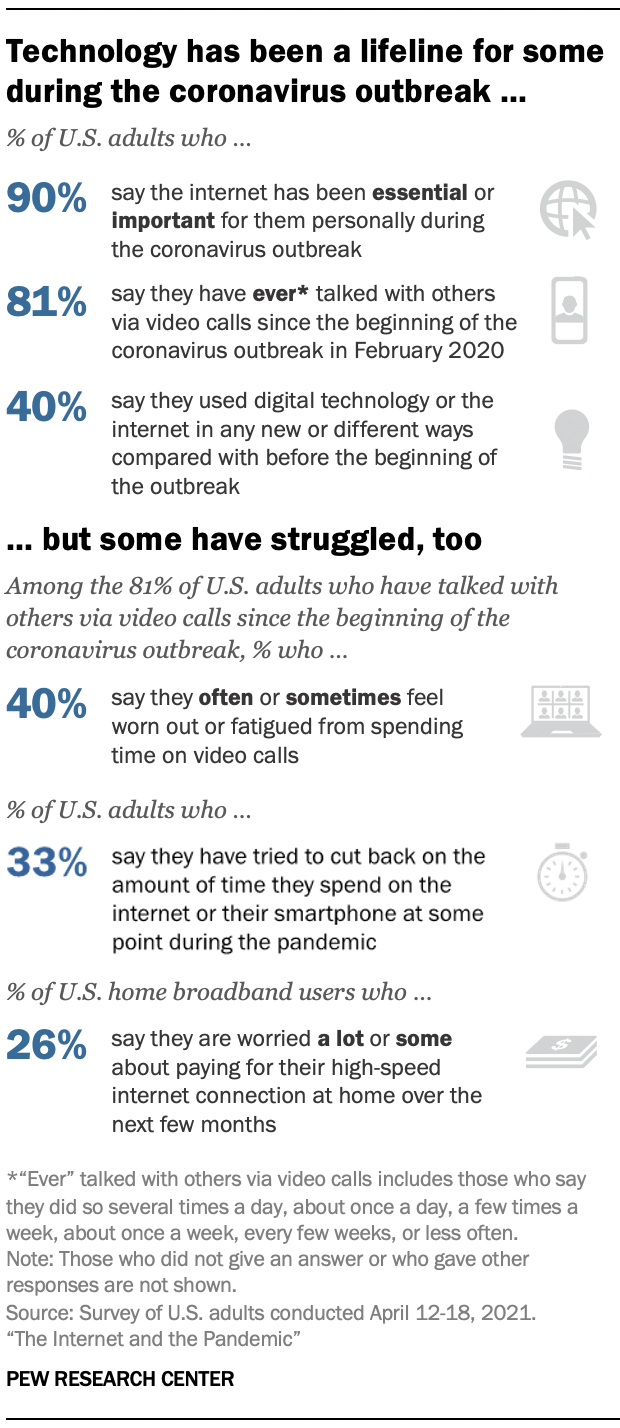
The coronavirus has transformed many aspects of Americans’ lives. It shut down schools, businesses and workplaces and forced millions to stay at home for extended lengths of time. Public health authorities recommended limits on social contact to try to contain the spread of the virus, and these profoundly altered the way many worked, learned, connected with loved ones, carried out basic daily tasks, celebrated and mourned. For some, technology played a role in this transformation.
Results from a new Pew Research Center survey of U.S. adults conducted April 12-18, 2021, reveal the extent to which people’s use of the internet has changed, their views about how helpful technology has been for them and the struggles some have faced.
The vast majority of adults (90%) say the internet has been at least important to them personally during the pandemic, the survey finds. The share who say it has been essential – 58% – is up slightly from 53% in April 2020. There have also been upticks in the shares who say the internet has been essential in the past year among those with a bachelor’s degree or more formal education, adults under 30, and those 65 and older.
A large majority of Americans (81%) also say they talked with others via video calls at some point since the pandemic’s onset. And for 40% of Americans, digital tools have taken on new relevance: They report they used technology or the internet in ways that were new or different to them. Some also sought upgrades to their service as the pandemic unfolded: 29% of broadband users did something to improve the speed, reliability or quality of their high-speed internet connection at home since the beginning of the outbreak.
Still, tech use has not been an unmitigated boon for everyone. “Zoom fatigue” was widely speculated to be a problem in the pandemic, and some Americans report related experiences in the new survey: 40% of those who have ever talked with others via video calls since the beginning of the pandemic say they have felt worn out or fatigued often or sometimes by the time they spend on them. Moreover, changes in screen time occurred for Americans generally and for parents of young children. The survey finds that a third of all adults say they tried to cut back on time spent on their smartphone or the internet at some point during the pandemic. In addition, 72% of parents of children in grades K-12 say their kids are spending more time on screens compared with before the outbreak.1
For many, digital interactions could only do so much as a stand-in for in-person communication. About two-thirds of Americans (68%) say the interactions they would have had in person, but instead had online or over the phone, have generally been useful – but not a replacement for in-person contact. Another 15% say these tools haven’t been of much use in their interactions. Still, 17% report that these digital interactions have been just as good as in-person contact.
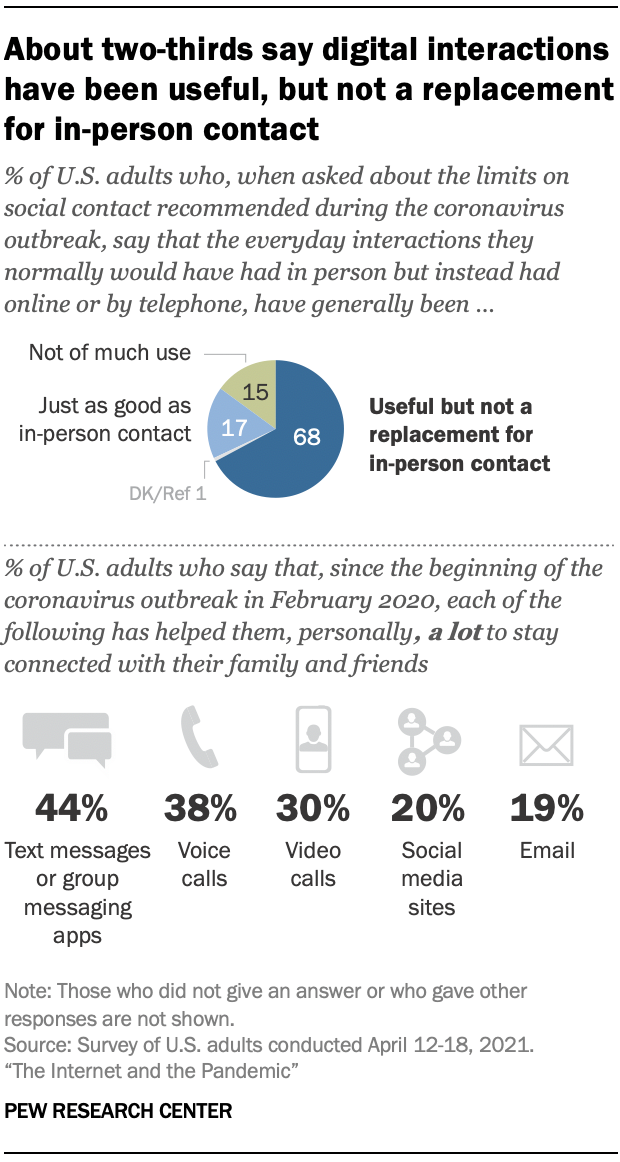
Some types of technology have been more helpful than others for Americans. For example, 44% say text messages or group messaging apps have helped them a lot to stay connected with family and friends, 38% say the same about voice calls and 30% say this about video calls. Smaller shares say social media sites (20%) and email (19%) have helped them in this way.
The survey offers a snapshot of Americans’ lives just over one year into the pandemic as they reflected back on what had happened. It is important to note the findings were gathered in April 2021, just before all U.S. adults became eligible for coronavirus vaccines. At the time, some states were beginning to loosen restrictions on businesses and social encounters. This survey also was fielded before the delta variant became prominent in the United States, raising concerns about new and evolving variants.
Here are some of the key takeaways from the survey.
Americans’ tech experiences in the pandemic are linked to digital divides, tech readiness
Some Americans’ experiences with technology haven’t been smooth or easy during the pandemic. The digital divides related to internet use and affordability were highlighted by the pandemic and also emerged in new ways as life moved online.
For all Americans relying on screens during the pandemic, connection quality has been important for school assignments, meetings and virtual social encounters alike. The new survey highlights difficulties for some: Roughly half of those who have a high-speed internet connection at home (48%) say they have problems with the speed, reliability or quality of their home connection often or sometimes.2
Beyond that, affordability remained a persistent concern for a portion of digital tech users as the pandemic continued – about a quarter of home broadband users (26%) and smartphone owners (24%) said in the April 2021 survey that they worried a lot or some about paying their internet and cellphone bills over the next few months.
From parents of children facing the “homework gap” to Americans struggling to afford home internet, those with lower incomes have been particularly likely to struggle. At the same time, some of those with higher incomes have been affected as well.

Affordability and connection problems have hit broadband users with lower incomes especially hard. Nearly half of broadband users with lower incomes, and about a quarter of those with midrange incomes, say that as of April they were at least somewhat worried about paying their internet bill over the next few months.3 And home broadband users with lower incomes are roughly 20 points more likely to say they often or sometimes experience problems with their connection than those with relatively high incomes. Still, 55% of those with lower incomes say the internet has been essential to them personally in the pandemic.
At the same time, Americans’ levels of formal education are associated with their experiences turning to tech during the pandemic.

Those with a bachelor’s or advanced degree are about twice as likely as those with a high school diploma or less formal education to have used tech in new or different ways during the pandemic. There is also roughly a 20 percentage point gap between these two groups in the shares who have made video calls about once a day or more often and who say these calls have helped at least a little to stay connected with family and friends. And 71% of those with a bachelor’s degree or more education say the internet has been essential, compared with 45% of those with a high school diploma or less.
More broadly, not all Americans believe they have key tech skills. In this survey, about a quarter of adults (26%) say they usually need someone else’s help to set up or show them how to use a new computer, smartphone or other electronic device. And one-in-ten report they have little to no confidence in their ability to use these types of devices to do the things they need to do online. This report refers to those who say they experience either or both of these issues as having “lower tech readiness.” Some 30% of adults fall in this category. (A full description of how this group was identified can be found in Chapter 3.)

These struggles are particularly acute for older adults, some of whom have had to learn new tech skills over the course of the pandemic. Roughly two-thirds of adults 75 and older fall into the group having lower tech readiness – that is, they either have little or no confidence in their ability to use their devices, or generally need help setting up and learning how to use new devices. Some 54% of Americans ages 65 to 74 are also in this group.
Americans with lower tech readiness have had different experiences with technology during the pandemic. While 82% of the Americans with lower tech readiness say the internet has been at least important to them personally during the pandemic, they are less likely than those with higher tech readiness to say the internet has been essential (39% vs. 66%). Some 21% of those with lower tech readiness say digital interactions haven’t been of much use in standing in for in-person contact, compared with 12% of those with higher tech readiness.
46% of parents with lower incomes whose children faced school closures say their children had at least one problem related to the ‘homework gap’
As school moved online for many families, parents and their children experienced profound changes. Fully 93% of parents with K-12 children at home say these children had some online instruction during the pandemic. Among these parents, 62% report that online learning has gone very or somewhat well, and 70% say it has been very or somewhat easy for them to help their children use technology for online instruction.
Still, 30% of the parents whose children have had online instruction during the pandemic say it has been very or somewhat difficult for them to help their children use technology or the internet for this.

The survey also shows that children from households with lower incomes who faced school closures in the pandemic have been especially likely to encounter tech-related obstacles in completing their schoolwork – a phenomenon contributing to the “homework gap.”
Overall, about a third (34%) of all parents whose children’s schools closed at some point say their children have encountered at least one of the tech-related issues we asked about amid COVID-19: having to do schoolwork on a cellphone, being unable to complete schoolwork because of lack of computer access at home, or having to use public Wi-Fi to finish schoolwork because there was no reliable connection at home.
This share is higher among parents with lower incomes whose children’s schools closed. Nearly half (46%) say their children have faced at least one of these issues. Some with higher incomes were affected as well – about three-in-ten (31%) of these parents with midrange incomes say their children faced one or more of these issues, as do about one-in-five of these parents with higher household incomes.
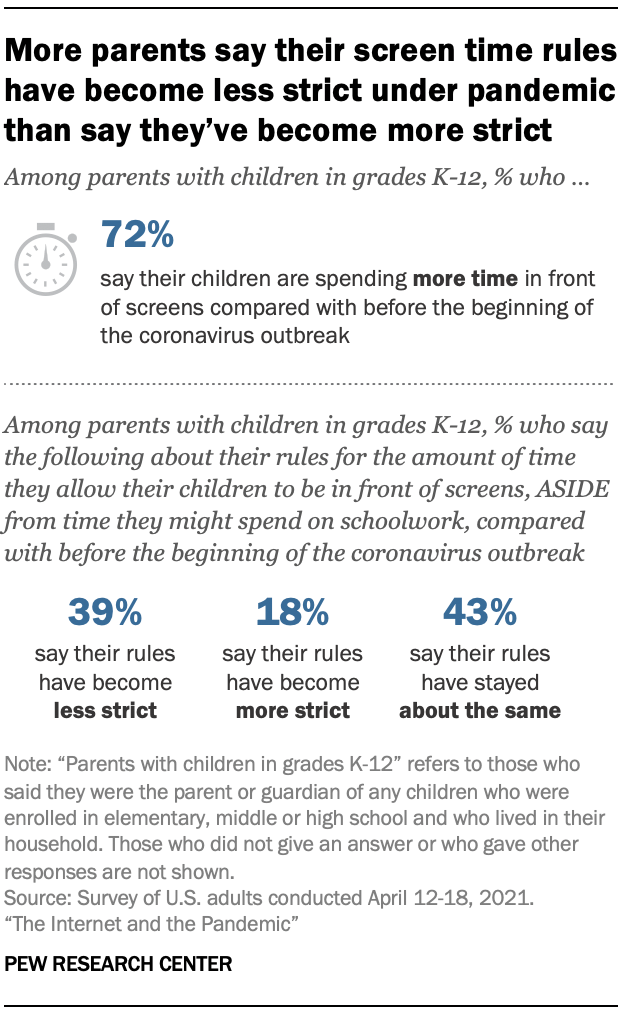
Prior Center work has documented this “homework gap” in other contexts – both before the coronavirus outbreak and near the beginning of the pandemic. In April 2020, for example, parents with lower incomes were particularly likely to think their children would face these struggles amid the outbreak.
Besides issues related to remote schooling, other changes were afoot in families as the pandemic forced many families to shelter in place. For instance, parents’ estimates of their children’s screen time – and family rules around this – changed in some homes. About seven-in-ten parents with children in kindergarten through 12th grade (72%) say their children were spending more time on screens as of the April survey compared with before the outbreak. Some 39% of parents with school-age children say they have become less strict about screen time rules during the outbreak. About one-in-five (18%) say they have become more strict, while 43% have kept screen time rules about the same.
More adults now favor the idea that schools should provide digital technology to all students during the pandemic than did in April 2020
Americans’ tech struggles related to digital divides gained attention from policymakers and news organizations as the pandemic progressed.
On some policy issues, public attitudes changed over the course of the outbreak – for example, views on what K-12 schools should provide to students shifted. Some 49% now say K-12 schools have a responsibility to provide all students with laptop or tablet computers in order to help them complete their schoolwork during the pandemic, up 12 percentage points from a year ago.
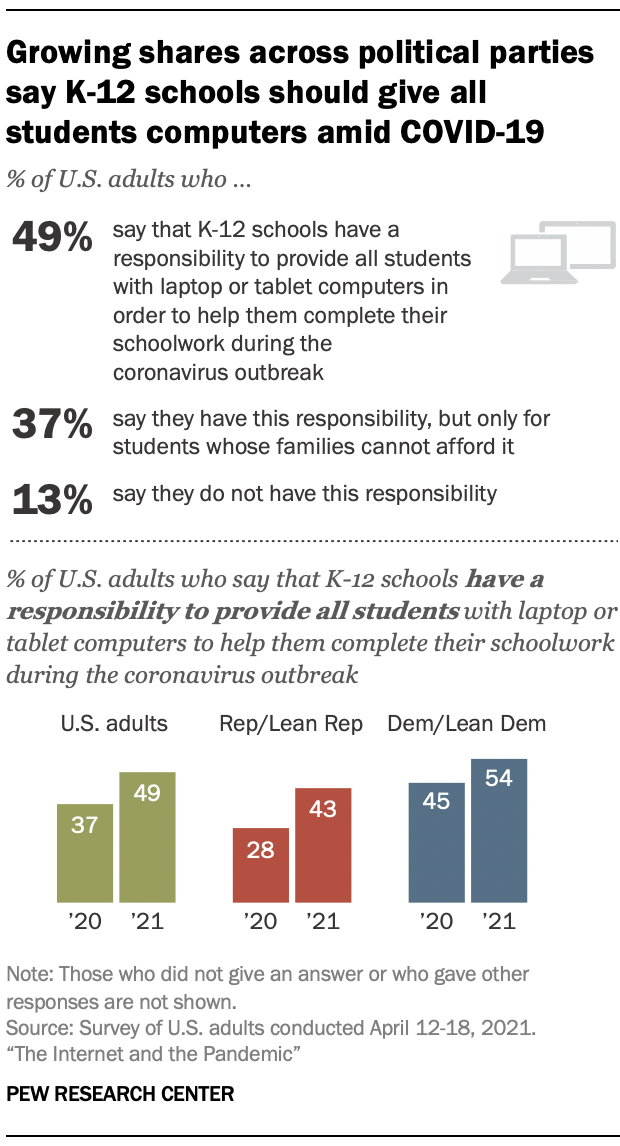
The shares of those who say so have increased for both major political parties over the past year: This view shifted 15 points for Republicans and those who lean toward the GOP, and there was a 9-point increase for Democrats and Democratic leaners.
However, when it comes to views of policy solutions for internet access more generally, not much has changed. Some 37% of Americans say that the government has a responsibility to ensure all Americans have high-speed internet access during the outbreak, and the overall share is unchanged from April 2020 – the first time Americans were asked this specific question about the government’s pandemic responsibility to provide internet access.4
Democrats are more likely than Republicans to say the government has this responsibility, and within the Republican Party, those with lower incomes are more likely to say this than their counterparts earning more money.
Video calls and conferencing have been part of everyday life
Americans’ own words provide insight into exactly how their lives changed amid COVID-19. When asked to describe the new or different ways they had used technology, some Americans mention video calls and conferencing facilitating a variety of virtual interactions – including attending events like weddings, family holidays and funerals or transforming where and how they worked.5 From family calls, shopping for groceries and placing takeout orders online to having telehealth visits with medical professionals or participating in online learning activities, some aspects of life have been virtually transformed:
“I’ve gone from not even knowing remote programs like Zoom even existed, to using them nearly every day.” – Man, 54
“[I’ve been] handling … deaths of family and friends remotely, attending and sharing classical music concerts and recitals with other professionals, viewing [my] own church services and Bible classes, shopping. … Basically, [the internet has been] a lifeline.”
– Woman, 69
“I … use Zoom for church youth activities. [I] use Zoom for meetings. I order groceries and takeout food online. We arranged for a ‘digital reception’ for my daughter’s wedding as well as live streaming the event.” – Woman, 44
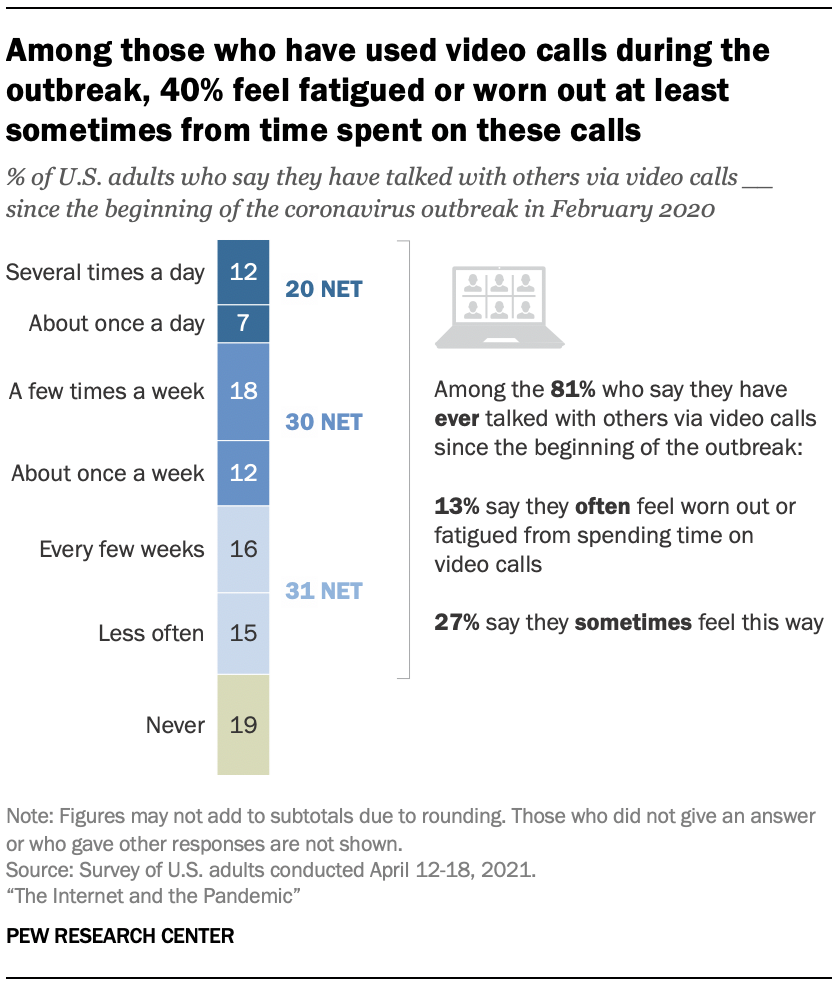
When asked about video calls specifically, half of Americans report they have talked with others in this way at least once a week since the beginning of the outbreak; one-in-five have used these platforms daily. But how often people have experienced this type of digital connectedness varies by age. For example, about a quarter of adults ages 18 to 49 (27%) say they have connected with others on video calls about once a day or more often, compared with 16% of those 50 to 64 and just 7% of those 65 and older.
Even as video technology became a part of life for users, many accounts of burnout surfaced and some speculated that “Zoom fatigue” was setting in as Americans grew weary of this type of screen time. The survey finds that some 40% of those who participated in video calls since the beginning of the pandemic – a third of all Americans – say they feel worn out or fatigued often or sometimes from the time they spend on video calls. About three-quarters of those who have been on these calls several times a day in the pandemic say this.
Fatigue is not limited to frequent users, however: For example, about a third (34%) of those who have made video calls about once a week say they feel worn out at least sometimes.
These are among the main findings from the survey. Other key results include:
Some Americans’ personal lives and social relationships have changed during the pandemic: Some 36% of Americans say their own personal lives changed in a major way as a result of the coronavirus outbreak. Another 47% say their personal lives changed, but only a little bit. About half (52%) of those who say major change has occurred in their personal lives due to the pandemic also say they have used tech in new ways, compared with about four-in-ten (38%) of those whose personal lives changed a little bit and roughly one-in-five (19%) of those who say their personal lives stayed about the same.
Even as tech helped some to stay connected, a quarter of Americans say they feel less close to close family members now compared with before the pandemic, and about four-in-ten (38%) say the same about friends they know well. Roughly half (53%) say this about casual acquaintances.
The majority of those who tried to sign up for vaccine appointments in the first part of the year went online to do so: Despite early problems with vaccine rollout and online registration systems, in the April survey tech problems did not appear to be major struggles for most adults who had tried to sign up online for COVID-19 vaccines. The survey explored Americans’ experiences getting these vaccine appointments and reveals that in April 57% of adults had tried to sign themselves up and 25% had tried to sign someone else up. Fully 78% of those who tried to sign themselves up and 87% of those who tried to sign others up were online registrants.
When it comes to difficulties with the online vaccine signup process, 29% of those who had tried to sign up online – 13% of all Americans – say it was very or somewhat difficult to sign themselves up for vaccines at that time. Among five reasons for this that the survey asked about, the most common major reason was lack of available appointments, rather than tech-related problems. Adults 65 and older who tried to sign themselves up for the vaccine online were the most likely age group to experience at least some difficulty when they tried to get a vaccine appointment.
Tech struggles and usefulness alike vary by race and ethnicity. Americans’ experiences also have varied across racial and ethnic groups. For example, Black Americans are more likely than White or Hispanic adults to meet the criteria for having “lower tech readiness.”6 Among broadband users, Black and Hispanic adults were also more likely than White adults to be worried about paying their bills for their high-speed internet access at home as of April, though the share of Hispanic Americans who say this declined sharply since April 2020. And a majority of Black and Hispanic broadband users say they at least sometimes have experienced problems with their internet connection.
Still, Black adults and Hispanic adults are more likely than White adults to say various technologies – text messages, voice calls, video calls, social media sites and email – have helped them a lot to stay connected with family and friends amid the pandemic.
Tech has helped some adults under 30 to connect with friends, but tech fatigue also set in for some. Only about one-in-five adults ages 18 to 29 say they feel closer to friends they know well compared with before the pandemic. This share is twice as high as that among adults 50 and older. Adults under 30 are also more likely than any other age group to say social media sites have helped a lot in staying connected with family and friends (30% say so), and about four-in-ten of those ages 18 to 29 say this about video calls.
Screen time affected some negatively, however. About six-in-ten adults under 30 (57%) who have ever made video calls in the pandemic say they at least sometimes feel worn out or fatigued from spending time on video calls, and about half (49%) of young adults say they have tried to cut back on time spent on the internet or their smartphone.


